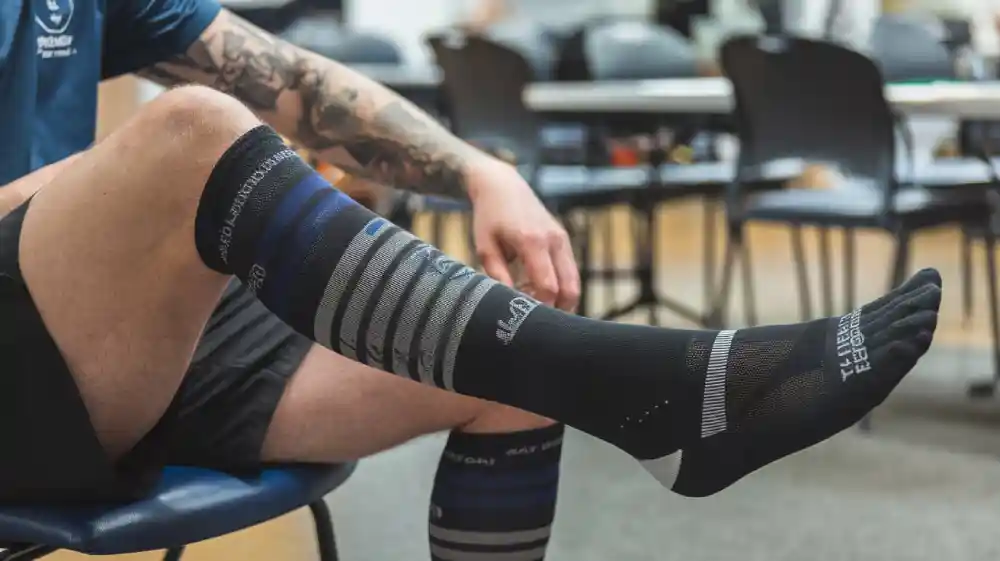
Finding the perfect fit for compression socks is critical, not only for comfort but also to ensure the therapeutic benefits of improved circulation, reduced swelling, and enhanced recovery. For brands looking to offer compression socks, providing the right fit is essential to differentiate your products in a competitive market. Whether targeting athletes, individuals with health conditions, or those seeking daily support, the right compression level can enhance customer satisfaction and loyalty.
In this article, we’ll explore why the fit matters, how to measure legs accurately, and how to select the appropriate compression level, so your product meets your customers’ diverse needs effectively.
Understanding Compression Socks: Features and Functionality
Compression socks are specialized garments designed to enhance circulation, benefiting athletes, individuals with circulatory issues, and those who stand for long hours. The key feature of compression socks is graduated pressure, which is tighter at the ankle and gradually loosens toward the top, helping to improve blood flow and reduce swelling.
For brands, compression socks provide an opportunity to offer customized products tailored to specific needs. With varying compression levels, materials, and design options, your brand can target diverse customer segments—from general wellness to medical-grade solutions.
The Science Behind Compression Therapy
Compression socks work by applying graduated pressure, facilitating blood flow upward toward the heart. This not only reduces the risk of conditions like deep vein thrombosis (DVT) but also aids in muscle recovery for athletes. For businesses, offering scientifically-backed compression socks provides clear value to customers seeking both performance and health benefits.
Selecting the Right Compression for Your Market
Compression levels are measured in mmHg (millimeters of mercury), which indicates the amount of pressure applied to the legs. Brands can choose from various levels of compression to meet the needs of their customers.
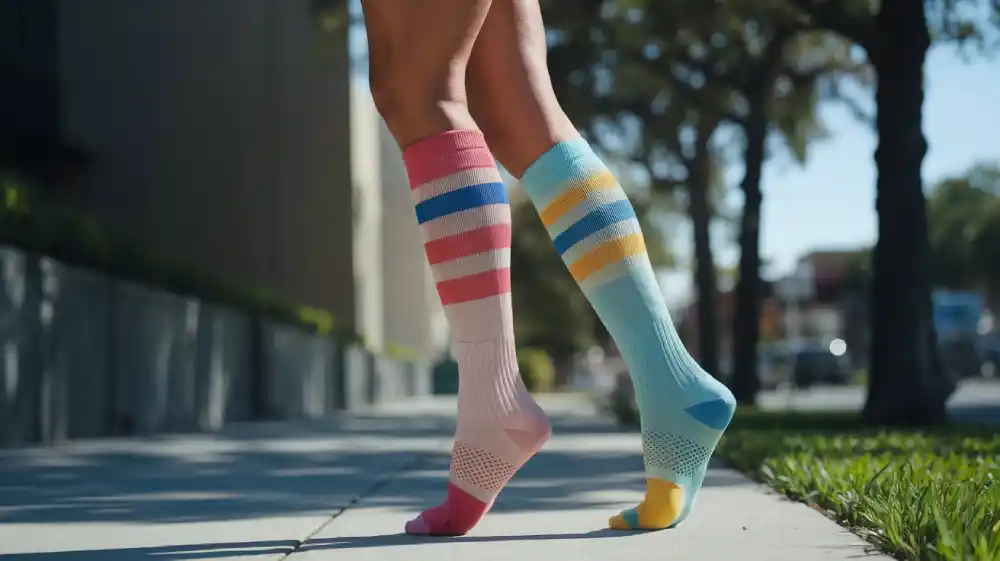
- 8-15 mmHg: Ideal for general wear to reduce fatigue and improve circulation.
- 15-20 mmHg: Provides moderate support, often recommended for individuals with mild circulatory issues or those recovering from light surgery.
- 20-30 mmHg and above: Medical-grade compression for managing more serious health conditions like varicose veins, edema, or post-surgical recovery.
For brands, offering these varying levels allows you to cater to a wide range of customer needs, from athletes looking for performance enhancement to those seeking relief from health conditions.
Factors Influencing the Fit of Compression Socks
Custom Sizing for Optimal Fit
The fit of compression socks is influenced by individual body size and shape, such as calf circumference and leg length. For brands, offering a range of sizes and custom-fit options ensures better support and comfort, improving the therapeutic effectiveness. Ill-fitting socks can reduce the benefits of compression, making accurate measurements and tailored designs crucial for both customer satisfaction and product performance.
Targeting Active Lifestyles and Rehabilitation Needs
Athletes and individuals with active lifestyles typically require higher compression levels (15-30 mmHg) to support muscle recovery and prevent fatigue during intense activities. Compression socks specifically designed for athletes can target muscle groups like the calves, offering more focused pressure where it’s needed most. Additionally, athletes seek breathable, moisture-wicking fabrics to ensure comfort during long workouts.
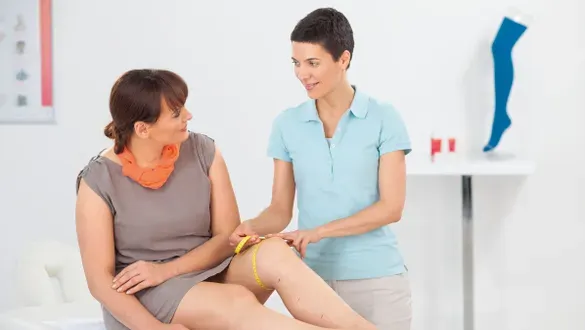
On the other hand, individuals with health conditions like varicose veins, chronic edema, or poor circulation need medical-grade compression socks to manage symptoms. Offering these specialized products enables brands to tap into a niche market of customers seeking therapeutic solutions.
Identifying Fit Issues: Too Tight or Too Loose?
Finding the right fit is crucial when it comes to compression wear. If they’re not fitting properly, compression socks can cause more harm than good. Whether they’re too tight or too loose, improper fit can reduce their effectiveness and lead to discomfort or even health problems. Here’s how to spot potential fit issues and ensure your socks are providing the optimal benefits.
Warning Signs of Overly Tight Compression Socks
Compression socks are effective only when they fit properly. If they are too tight, they can cause discomfort and health issues. The main signs of overly tight compression socks include:
- Pain and Restriction: A pinched sensation or tingling indicates too much pressure.
- Red Marks or Indentations: If marks appear after removing the socks, they may be restricting circulation, which can worsen the problem.
- Swelling: Excessively tight socks can impede blood flow and result in swelling.
For B2B brands, understanding these symptoms is crucial for advising customers and ensuring the products they offer are effective and comfortable. Custom sizing and appropriate compression levels are key to avoiding these issues.
Common Problems with Loosely Fitted Socks
Loose socks, while seemingly more comfortable, fail to deliver the necessary therapeutic benefits. They lack the right pressure to improve circulation, leading to:
- Inconsistent Pressure: Loose socks may shift during wear, creating areas with no pressure at all.
- Discomfort: Shifting socks can cause irritation, chafing, or blisters.
Offering products with customizable sizing or adjustable compression levels can help businesses ensure that their compression socks provide consistent support and comfort throughout the day.
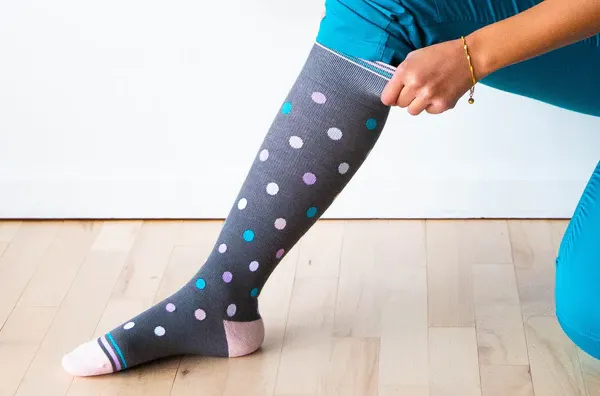
Health Risks Associated with Improper Fit
Whether socks are too tight or too loose, improper fit can cause health risks. Tight socks can restrict circulation, potentially increasing the risk of blood clots, while loose socks won’t prevent fluid buildup in the legs, exacerbating conditions like edema or varicose veins. Brands that provide properly fitted compression socks can reduce these risks and enhance the effectiveness of their products.
Measuring for the Perfect Fit: A Step-by-Step Guide
Accurate measurements are crucial for selecting the right compression socks. For B2B companies, providing customers with clear instructions on how to measure for the perfect fit can ensure satisfaction. Here’s how to measure legs properly:
- Ankle Circumference: Measure around the narrowest part of the ankle, just above the bone, where compression will be strongest.
- Calf Circumference: Measure the widest part of the calf to ensure adequate support.
- Leg Length: For knee-high socks, measure from the floor to just below the knee. For thigh-highs, measure from the floor to the top of the thigh.
- Optional – Thigh Circumference: For thigh-high socks, measure the fullest part of the thigh to ensure proper fit and prevent slippage.
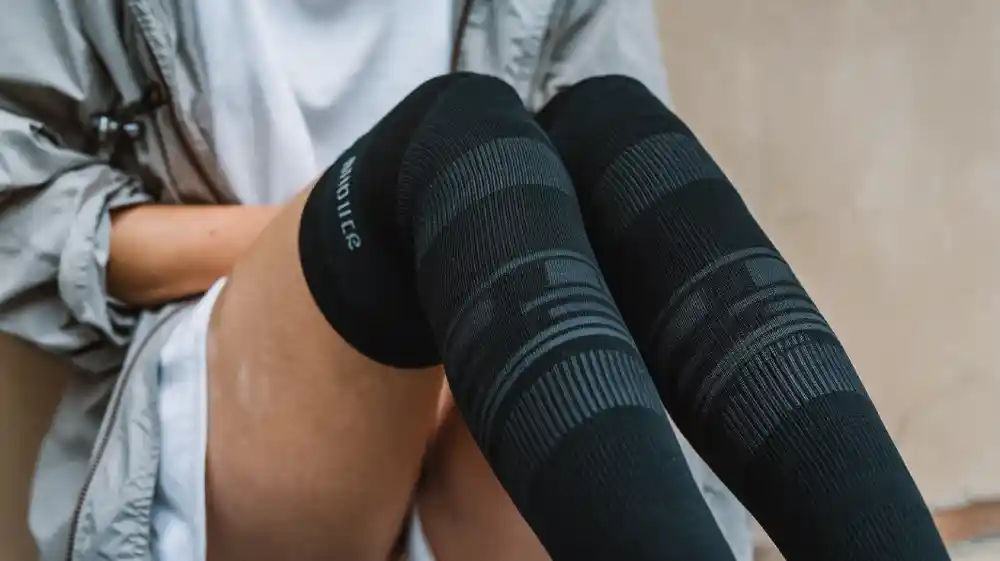
Choosing the Right Size Based on Your Measurements
Once the measurements are taken, brands can guide their customers in selecting the best fit. Compression socks come with sizing charts that correlate to specific measurements:
- Calf and Ankle: If measurements fall between sizes, it’s better to select the larger size to avoid restriction.
- Sock Length: Knee-high and thigh-high socks should fit comfortably without slipping or bunching.
- Compression Level: For general use, mild to moderate compression (8-20 mmHg) is usually sufficient, but for healthcare or high-performance purposes, higher levels (20-30 mmHg) may be necessary.
Jiaxing Max Hosiery offers customizable size solutions, ensuring brands can provide a variety of sizes and compression levels tailored to their customers’ needs.
Practical Tips for Achieving and Maintaining Optimal Comfort
- Techniques to Ensure a Perfect Fit Every Time
To ensure the compression socks fit properly, guide your customers to always measure their legs and follow the sizing chart. For businesses, offering detailed instructions or even sample products for testing can help customers achieve the perfect fit. When wearing the socks, it’s essential to:
1. Start at the toes and smooth upwards to avoid wrinkles.
2. Align the heel properly and ensure no sagging or bunching.
3. For thigh-high socks, ensure the top stays in place—silicone bands are a useful feature.
Providing products that come with easy-to-follow sizing guides and fit tips will elevate the customer experience and reduce fit-related complaints.
- What to Do If Your Compression Socks Feel Uncomfortable
If discomfort arises, the first step is to check the fit. If socks are too tight or loose, recommend customers adjust or select a different size. For B2B businesses, offering a variety of sizes, compression levels, and materials will ensure a solution for every need. If discomfort persists, a healthcare consultation might be necessary.
Providing customizable options can allow businesses to offer a personalized experience to their customers, making their compression socks truly effective.
- Maintaining Comfort Throughout Your Day
Encourage customers to periodically check their socks and make adjustments if they feel loose. In addition, provide clear instructions on how to care for compression socks to ensure longevity and consistent performance. For B2B companies, including care instructions with your products not only helps the end user but also builds your brand’s credibility. Offering high-quality, easy-care socks can result in fewer returns and higher customer satisfaction.
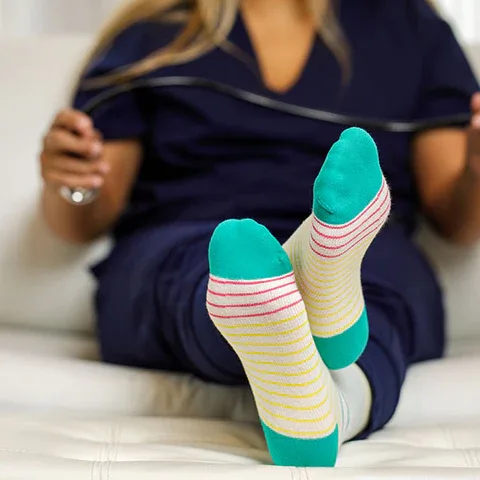
When to Wear Compression Socks for Maximum Benefit
The Best Times to Wear Compression Socks (Day vs. Night)
Compression socks are most beneficial when worn during the day, especially for customers who are on their feet for long hours. For B2B businesses, offering daytime compression socks can cater to industries like retail, healthcare, or travel. Brands can also offer options for night wear for customers recovering from surgery or managing chronic circulatory issues.
Understanding the different wear patterns allows brands to diversify their product range and address a wider audience with specific needs.
Activities That Benefit Most from Compression Socks
Compression socks offer performance benefits across various activities:
- Athletes: To improve recovery during and after exercise.
- Healthcare Workers: To reduce fatigue from long periods of standing.
- Travelers: To prevent DVT and leg discomfort during flights.
For businesses, targeting these specific use cases with tailored designs can position your products as essential items for your customers’ daily needs.
How Long Should You Wear Compression Socks for Optimal Results?
The duration for wearing compression socks depends on the intended use. For travel, wearing them during the flight is recommended. For athletic performance, use them during and after exercise. For health conditions, extended wear throughout the day may be necessary. Brands should educate their customers on the duration and timing for maximum benefit.
Offering a range of wear times and compression levels gives customers the flexibility to find the best solution for their individual needs.
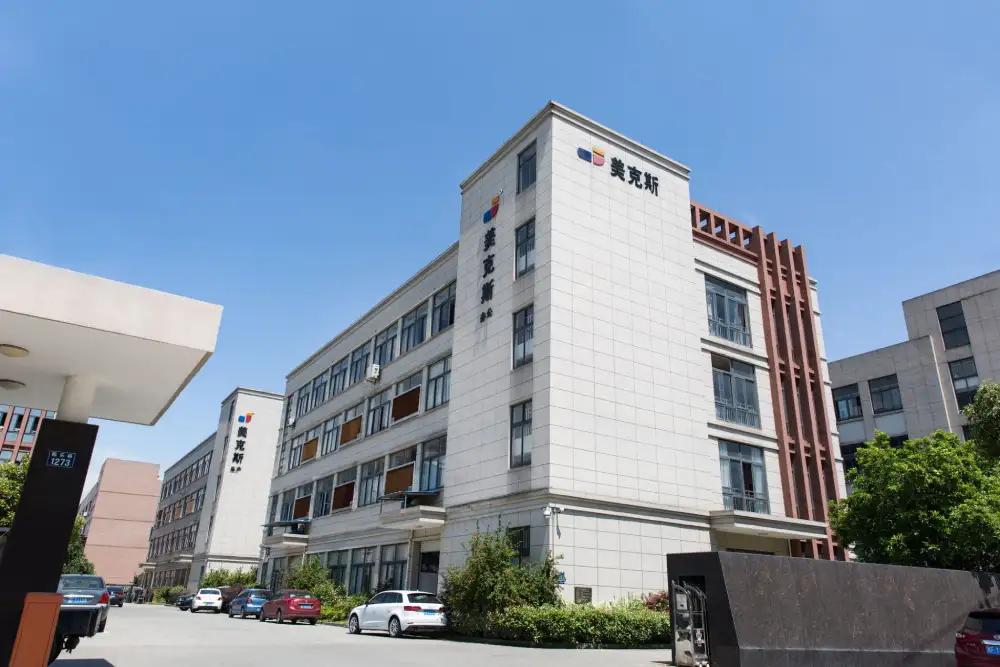
Partner with Jiaxing Max Hosiery for Custom Compression Sock Solutions
As demand for customized compression socks increases, brands can rely on Jiaxing Max Hosiery for high-quality, scalable production. Whether you’re looking to create a line of wellness socks for your retail customers or launch a medical-grade product for your healthcare market, Jiaxing Max Hosiery can support your business with:
Custom Design & Branding
Stand out with unique designs and logos tailored to your brand. We offer full customization for sock designs, colors, patterns, and packaging, helping your products align with your brand identity and appeal to your target market. Our private label options allow you to build a stronger brand presence, from the socks themselves to the packaging, ensuring your customers recognize your brand immediately.
Flexible Compression Levels
Offer a variety of compression options to meet the diverse needs of your customers. From light compression for everyday wear to stronger levels for medical applications or athletic recovery, we tailor the compression levels to match the needs of different customer segments. We also offer compression testing to ensure consistency and effectiveness, delivering high-quality products that meet the exact needs of your clientele.
Bulk Orders & Scalable Production
Whether you need large-scale production for national retail chains or smaller runs for niche markets, we offer flexible manufacturing solutions to meet your needs. Our scalable production capabilities allow us to handle both large and small orders with ease, ensuring fast delivery times and competitive pricing, making sure your business stays ahead of the competition.
Eco-Friendly Materials & Fast Turnaround
Produce high-quality, eco-conscious products with sustainable materials that meet the growing demand for environmentally friendly products. We offer fast turnaround times to ensure your products reach the market as quickly as possible. Our efficient production process minimizes delays, even for large orders, ensuring that you can meet tight deadlines and demand fluctuations.
By partnering with us, your brand can offer superior custom compression socks that address a wide array of health and performance needs. Whether for athletes, individuals with health conditions, or general wellness, we provide high-quality products that stand out in the marketplace.
Conclusion: Maximizing Benefits with the Right Compression Sock Fit
Achieving the perfect fit ensures customers receive the full therapeutic benefits of compression socks. Brands should offer products with accurate sizing and varying compression levels to address the needs of different customer segments.
For businesses, offering customizable compression socks designed to meet specific needs—whether athletic, health, or general wellness—can help your brand stand out in the market. Partnering with Jiaxing Max Hosiery allows you to provide high-quality, tailored products that improve your customers’ comfort and health outcomes.
Ready to Enhance Your Product Line?
Contact Jiaxing Max Hosiery today to explore how we can help your brand create custom compression socks tailored to your customers’ needs. With our expertise, you can deliver products that ensure both comfort and effectiveness.
FAQ
Are Compression Socks Supposed to Be Tight?
Compression socks should fit snugly to provide effective pressure, with the most compression at the ankle, gradually decreasing upwards. If they feel overly tight or restrictive, they may be too small or too high in compression. For B2B brands, offering a variety of sizes and compression levels allows you to cater to different customer needs, whether they require light support or medical-grade compression. Jiaxing Max Hosiery can help you create custom-fit solutions tailored to your target market.
How Can Compression Socks Benefit Your Traveling Customers?
Compression socks are ideal for long trips, preventing blood from pooling in the legs and reducing swelling or clots. For brands in the travel or leisure sector, customizing compression socks for this purpose can be a great addition to your product offerings. Jiaxing Max Hosiery’s manufacturing capabilities can help you design travel-specific compression socks that cater to customers looking for comfort and support during long flights or road trips.
Can Compression Socks Be Worn All Day?
Compression socks are typically safe to wear for extended periods, particularly for individuals who stand or sit for long hours. For brands, offering options designed for all-day wear can meet the needs of workers, travelers, and athletes. We offer customizable compression socks designed for both everyday comfort and specific uses, giving your brand the flexibility to serve various markets, from healthcare to travel.
Do compression socks help with swelling?
Yes, compression socks reduce swelling by promoting better blood circulation and preventing fluid buildup, which is beneficial for conditions like edema or varicose veins. For brands, offering socks tailored to healthcare or recovery needs can expand your product line and attract a wider audience. We specialize in custom compression socks, allowing you to offer products that effectively address both health and comfort needs.
Can compression socks improve athletic performance?
Compression socks support circulation, reduce muscle fatigue, and aid recovery during physical activities. For brands targeting athletes or fitness enthusiasts, offering socks designed for sports recovery or performance enhancement can strengthen your market position.We provide custom solutions, allowing you to create high-performance compression socks that meet the specific needs of your athletic clientele.
